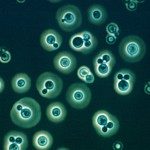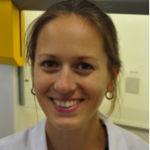Link to Pubmed [PMID] – 29775480
Link to DOI – 10.1371/journal.ppat.1006982
PLoS Pathog 2018 05; 14(5): e1006982
The pathogenic fungus Cryptococcus neoformans exhibits morphological changes in cell size during lung infection, producing both typical size 5 to 7 μm cells and large titan cells (> 10 μm and up to 100 μm). We found and optimized in vitro conditions that produce titan cells in order to identify the ancestry of titan cells, the environmental determinants, and the key gene regulators of titan cell formation. Titan cells generated in vitro harbor the main characteristics of titan cells produced in vivo including their large cell size (>10 μm), polyploidy with a single nucleus, large vacuole, dense capsule, and thick cell wall. Here we show titan cells derived from the enlargement of progenitor cells in the population independent of yeast growth rate. Change in the incubation medium, hypoxia, nutrient starvation and low pH were the main factors that trigger titan cell formation, while quorum sensing factors like the initial inoculum concentration, pantothenic acid, and the quorum sensing peptide Qsp1p also impacted titan cell formation. Inhibition of ergosterol, protein and nucleic acid biosynthesis altered titan cell formation, as did serum, phospholipids and anti-capsular antibodies in our settings. We explored genetic factors important for titan cell formation using three approaches. Using H99-derivative strains with natural genetic differences, we showed that titan cell formation was dependent on LMP1 and SGF29 genes. By screening a gene deletion collection, we also confirmed that GPR4/5-RIM101, and CAC1 genes were required to generate titan cells and that the PKR1, TSP2, USV101 genes negatively regulated titan cell formation. Furthermore, analysis of spontaneous Pkr1 loss-of-function clinical isolates confirmed the important role of the Pkr1 protein as a negative regulator of titan cell formation. Through development of a standardized and robust in vitro assay, our results provide new insights into titan cell biogenesis with the identification of multiple important factors/pathways.






